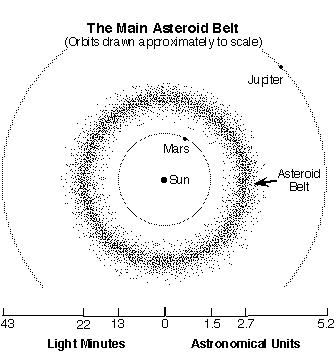 Asteroid Introduction
Asteroid Introduction Asteroid Introduction
Asteroid Introduction

Asteroids are rocky and metallic objects that orbit the Sun but are too small to be considered planets. They are known as minor planets. Asteroids range in size from Ceres, which has a diameter of about 1000 km, down to the size of pebbles. Sixteen asteroids have a diameter of 240 km or greater. They have been found inside Earth's orbit to beyond Saturn's orbit. Most, however, are contained within a main belt that exists between the orbits of Mars and Jupiter. Some have orbits that cross Earth's path and some have even hit the Earth in times past. One of the best preserved examples is Barringer Meteor Crater near Winslow, Arizona.

Asteroids are material left over from the formation of the solar system. One theory suggests that they are the remains of a planet that was destroyed in a massive collision long ago. More likely, asteroids are material that never coalesced into a planet. In fact, if the estimated total mass of all asteroids was gathered into a single object, the object would be less than 1,500 kilometers (932 miles) across -- less than half the diameter of our Moon.
Much of our understanding about asteroids comes from examining pieces of space debris that fall to the surface of Earth. Asteroids that are on a collision course with Earth are called meteoroids. When a meteoroid strikes our atmosphere at high velocity, friction causes this chunk of space matter to incinerate in a streak of light known as a meteor. If the meteoroid does not burn up completely, what's left strikes Earth's surface and is called a meteorite.
Of all the meteorites examined, 92.8 percent are composed of silicate (stone), and 5.7 percent are composed of iron and nickel; the rest are a mixture of the three materials. Stony meteorites are the hardest to identify since they look very much like terrestrial rocks.
Because asteroids are material from the very early solar system, scientists are interested in their composition. Spacecraft that have flown through the asteroid belt have found that the belt is really quite empty and that asteroids are separated by very large distances. The Galileo spacecraft recently made close encounters with asteroids 951 Gaspra and 243 Ida.

The following pages contain information on several asteroids that have been studied during the last few years. The Galileo spacecraft flew past Gaspra in October 1991 and Ida in August 1993. During these encounters, high resolution images were obtained. Astronomers studied Toutatis and Geographos using Earth-based radar observations during close approaches to the Earth. Scientists generated computer models of Castalia using date acquired from radar/radio telescopes. Vesta was observed by the Hubble Space Telescope.

Radius Distance*
Num Name (km) (10^6km) Albedo Discoverer Date
---------------------------------------------------------
1 Ceres 457 413.9 0.10 G. Piazzi 1801
511 Davida 168 475.4 0.05 R. Dugan 1903
15 Eunomia 136 395.5 0.19 De Gasparis 1851
52 Europa 156 463.3 0.06 Goldschmidt 1858
10 Hygiea 215 470.3 0.08 De Gasparis 1849
704 Interamnia 167 458.1 0.06 V. Cerulli 1910
2 Pallas 261 414.5 0.14 H. Olbers 1802
16 Psyche 132 437.1 0.10 De Gasparis 1852
87 Sylvia 136 521.5 0.04 N. Pogson 1866
4 Vesta 262.5 353.4 0.38 H. Olbers 1807
951 Gaspra 17x10 205.0 0.20 Neujmin 1916
243 Ida 58x23 270.0 ? J. Palisa 29 Sep 1884
* Mean distance from the Sun.


 Return to Pluto
Return to Pluto
 Visit the Comets
Visit the Comets

